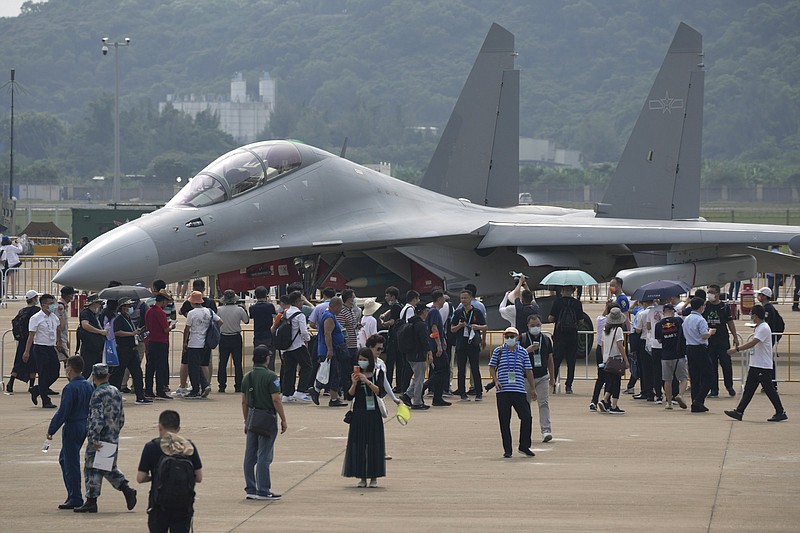Record-breaking numbers of Chinese military planes probed the airspace near Taiwan over the weekend, prompting Taiwanese fighter jets to scramble and adding muscle to Beijing's warnings that it could ultimately use force to take hold of the island.
The sorties by nearly 80 People's Liberation Army aircraft on Friday and Saturday, as China observed its National Day holiday, followed a pattern of Beijing testing and wearing down Taiwan by flying over seas southwest of the island. The most recent flights stood out because of the number and types of planes involved, including bombers and anti-submarine planes on nighttime intrusions.
The flights did not suggest an imminent threat of war over Taiwan, said several analysts, but they did reflect Beijing's increasingly unabashed signaling that it wants to absorb the self-ruled island and will not rule out military means to do so.
"Coming on Oct. 1, China's National Day, it sends a message about Beijing's determination to claim Taiwan, by force if necessary," said Adam Ni, an Australian analyst of Chinese military policy who is based in Germany. "The aim of this is to assert Beijing's power and show military muscle."
Taiwan's Ministry of National Defense said that the spike in flights began Friday, when 38 Chinese military planes flew into the island's "air defense identification zone."
The first group of aircraft included two H-6 bombers and 22 fighter jets, according to the Taiwanese ministry. That night, another two H-6 bombers, accompanied by 10 J-16 fighters, flew into the air zone, turned left off the southern end of Taiwan and headed northeast, parallel to the island's eastern coast, before turning back, it showed on a map.
On Saturday, 39 Chinese military planes -- including fighter jets, two anti-submarine aircraft and an early-warning-and-control plane -- entered the Taiwanese zone, again breaking the daily record, the ministry said. On Sunday, it reported, 16 more planes, including a dozen fighter jets, cut into a corner of the same area of the zone.
Taiwan's air identification zone dates to the 1950s, laying out the airspace where the island's authorities assert the right to tell entering planes to identify themselves and their purpose.
It is a much larger area than Taiwan's sovereign airspace, which reaches 12 nautical miles from its coast. The Chinese flights did not enter that sovereign airspace.
"It is very worrying," said Chieh Chung, a security analyst with the National Policy Foundation in Taipei, Taiwan's capital. "This puts a lot more pressure on our military, and the more they reach into our airspace, the greater the risk of some kind of accident."
Taiwan's defense ministry began regularly releasing records of Chinese military flights into the space in September 2020. Chinese military planes now enter the zone nearly every day, and the latest waves have barely ruffled most people in Taiwan. Officials on the island sounded more worried, however.
The U.S. State Department condemned what it called China's "provocative military activity near Taiwan." Ned Price, a spokesperson for the department, said Sunday that the action was "destabilizing, risks miscalculations, and undermines regional peace and stability."
Taiwan's military responded to the latest Chinese flights by sending its own fighter jets into the air to monitor, but not confront, the planes. The strain of responding to China's regular intrusions is wearing on Taiwanese pilots and aircraft, and it could be affecting the island's overall vigilance, experts said.
"What I think is clear is that they're having some success wearing down Taiwan with this operational tempo," Zack Cooper, a senior fellow at the American Enterprise Institute who studies Chinese and regional military issues, said in an interview. "It's tough on the pilots, it uses gas, which is expensive, and these air frames -- the more you use them, the quicker they age."
The Chinese government has said nothing about the flights, while official Chinese news outlets cited the Taiwanese reports that they had set a record.
China's flights into the Taiwanese zone usually feature slower-moving reconnaissance and anti-submarine aircraft, as well as fighter jets, according to records compiled by Gerald C. Brown, a defense analyst in Washington. But this year, Brown's data indicates, the Chinese air force has sent bombers more often -- an intimidating step, because they could more likely carry out a real attack.
The large-scale night flights also suggested that Chinese pilots had honed their abilities to fly their J-16 fighter jets in darkness, said Su Tzu-yun, a senior analyst at the Taipei-based Institute for National Defense and Security Research, which is backed by Taiwan's government.
"They are trying to show all-weather capability," said Su. "They want to show that they can fight battles in the daytime and try to strike at nighttime."
By the end of 2019, China had around 1,500 fighter jets and 450 bombers and attack planes, according to the Pentagon's 2020 report on the People's Liberation Army. Taiwan had 400 fighters and no bombers.
Taiwan's security increasingly depends on the United States, which provides most of its weapons. Under a 1979 law, the United States could intervene in an attempted military takeover of Taiwan, but it is not obliged to do so.
The U.S. on Sunday called on China to halt its "provocative" pressure on Taiwan after a record number of daily incursions by Chinese warplanes, saying the military actions are destabilizing and risk leading to "miscalculations."
"The U.S. commitment to Taiwan is rock solid and contributes to the maintenance of peace and stability across the Taiwan Strait and within the region," the State Department's Price said in a statement on Sunday.
"We urge Beijing to cease its military, diplomatic, and economic pressure and coercion against Taiwan."
Information for this article was contributed by Chris Buckley and Amy Qin of The New York Times and by Cindy Wang and Jacob Gu of Bloomberg News.

